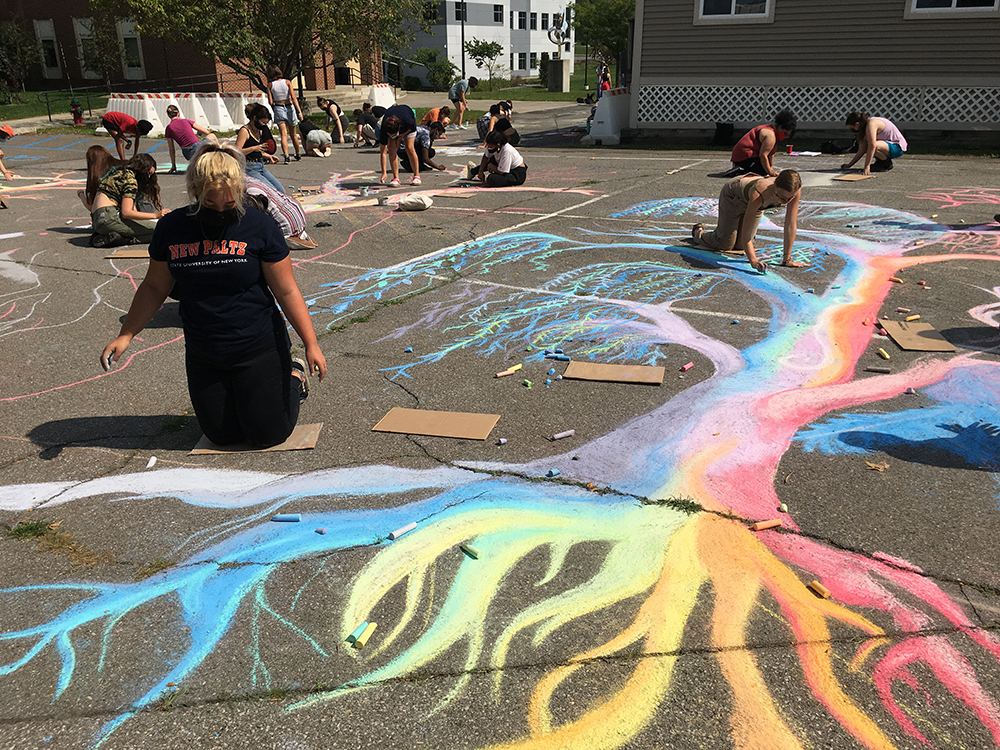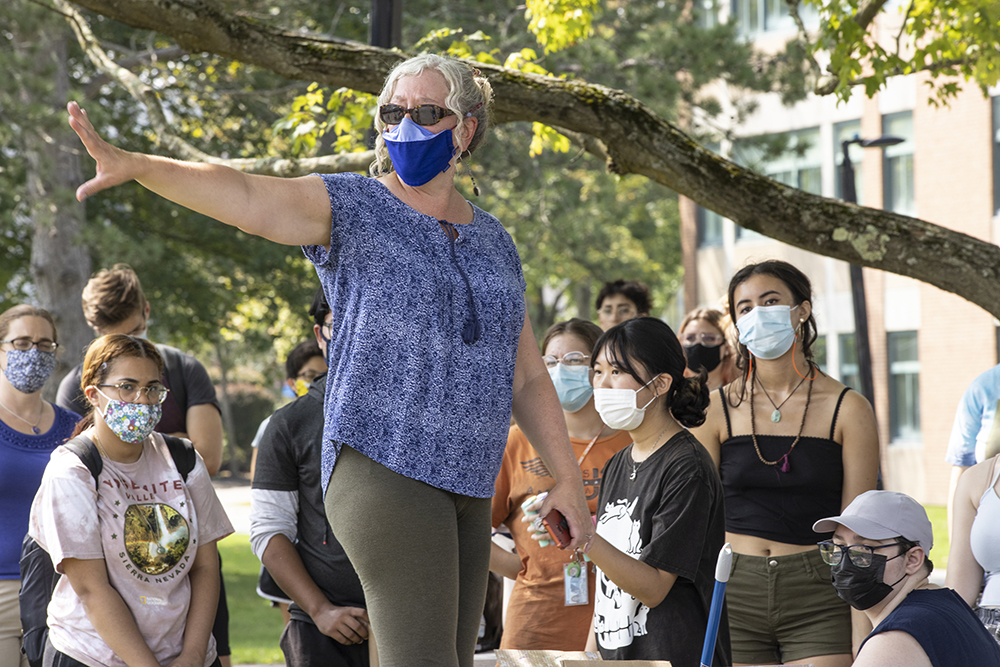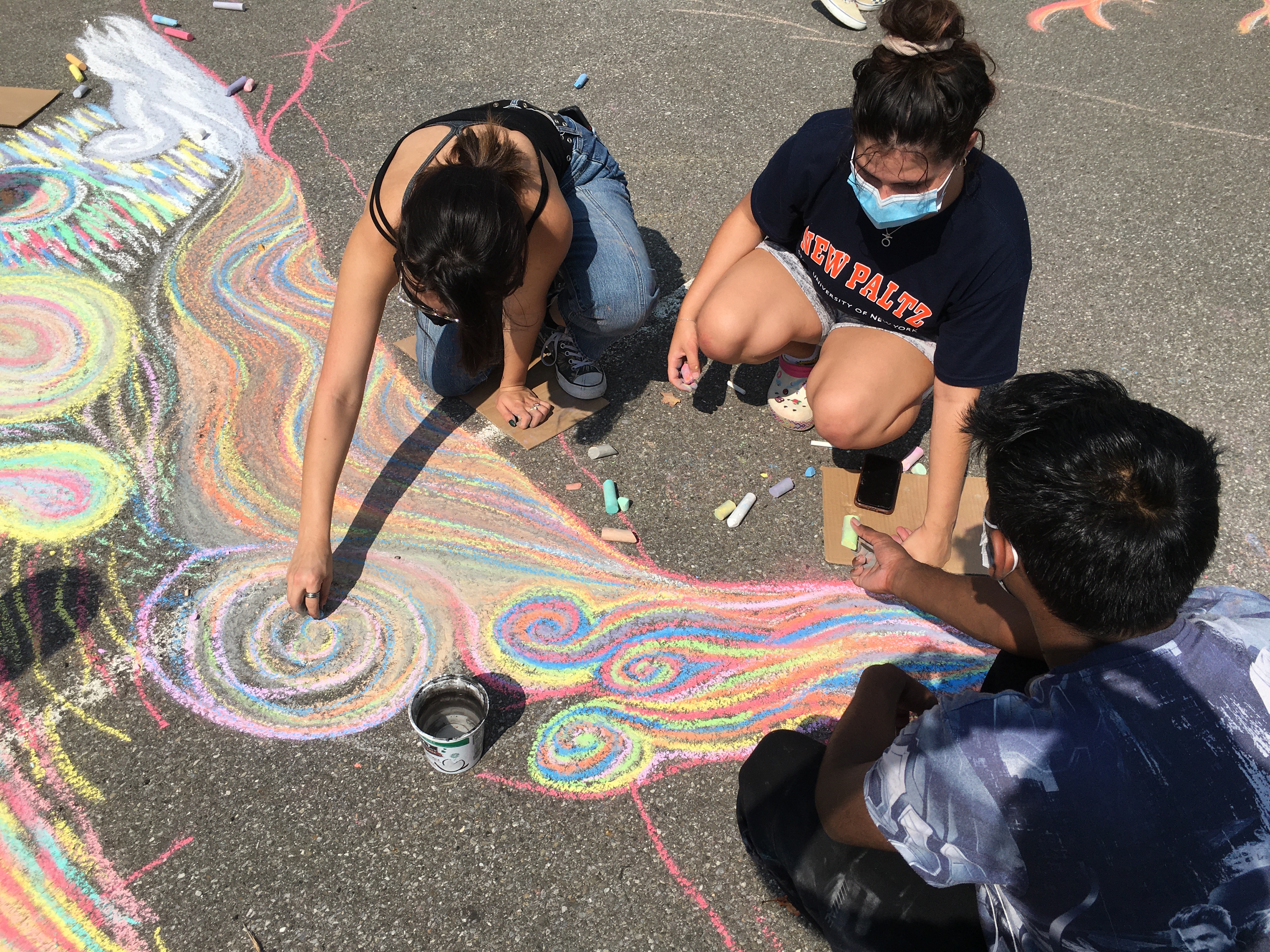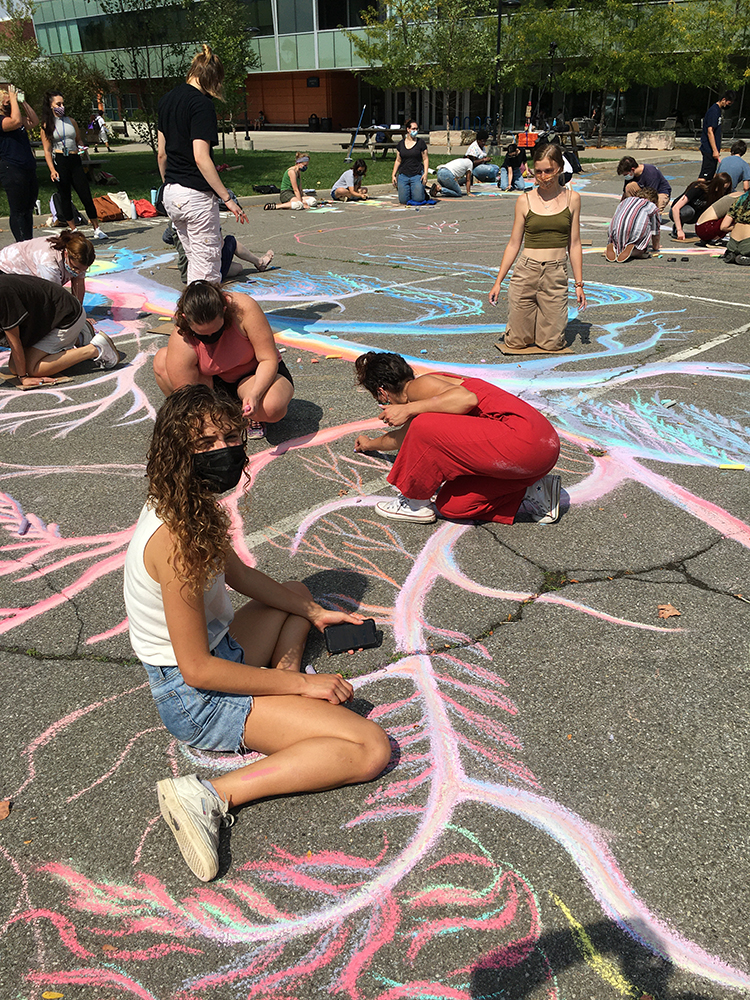
Chalk It Up: Foundation Art Community Event Branches Out, Makes Connections, Builds Community, Finds Common Roots
Written by Suzanne Stokes, Foundation Coordinator, Professor/Art Department
Edited by Wendy Vierow, Coordinator, Office of Strategic Planning & Assessment
When freshmen and transfer students enter the Art Department, they spend their first year in the Foundation Program. They take a series of five courses including Visual Thinking: Drawing I, Visual Thinking: Drawing II, Design: Color, Design: Form and Art Seminar. They also participate in a variety of community building events in the Foundation program, the Art Department and the School of Fine & Performing Arts. The event was led by Suzanne Stokes, Jim Fossett, Itty Neuhaus, Cheryl Wheat, Ana Maria Farina ’21g, and Tom Blake.
On the afternoon of September 15, 2021, the Foundation students, faculty, and staff of the Art Department transformed Coykendall parking lot #22. The event was called “Chalk It Up! Foundation Community Event. Branch Out-Make Connections-Build Community-Find Common Roots.”
Students were asked to consider how trees form a community from the roots up; how they communicate as individuals in a forest; how such social interaction relates to their growth as an individual; and how their community contributes to that experience.

On that very warm (90°+) day, 163 Foundation Art students met with Foundation Art faculty and staff at the site to create their own particular forest together. This massive collaboration had students working in teams to create a large variety of trees, which throughout the course of the day turned into a captivating forest full of known and fantastical trees, undergrowth, critters who exist within this world, and more for viewers to contemplate and enjoy.
Each year, the Foundation Art faculty plan and hold a welcome Kick-Off event for the incoming freshman and transfers. For several years, this has taken place at the Ashokan Center in Olivebridge, New York, for a full day of workshops in an extraordinary natural setting that focus on sustainability and community building. This year, due to COVID, the faculty decided to be safe and stay close to home on campus.
In Foundation Art, we believe that it is essential for our students to deeply understand sustainability and what they can do in their lives to help change the trajectory of issues specific to the environmental, social, and economic sustainability. One goal for Chalk It Up! was for students to learn about the science and the supportive nature of how trees coexist as a community and how this relationship is a metaphor for the students themselves in terms of community building, branching out, making connections, and finding common roots. Another important goal was for students to work together to collaboratively create a work of art and to have an unforgettable positive experience.

In preparation for Chalk It Up! art students watched three videos and wrote about each video, focusing on the information that was the most surprising to them and brainstorming how they could be part of environmental change. They watched Real Science’s “The Secret Language of Trees,” Suzanne Simard’s TED talk “How Trees Talk to Each Other,” and Peter Wohlleben’s “Talking to Trees.” They also listened to a one-hour Radiolab podcast, “From Tree to Shining Tree,” and wrote about what they learned.
After researching and writing, students chose three trees that were of particular interest to them personally, and carefully drew each one of them in their sketchbooks or on large pieces of drawing paper. Two of the trees they drew were from observation—we asked them to go outside, locate their trees, get comfortable, and start drawing. They were to observe the trees very closely, paying attention to their particular forms; the way they move through space; color palettes that exist within them; texture of the bark; type and shape of the leaf, seeds, configuration; and type of branches; their root systems (both seen and unseen); creatures they may attract; settings where they grow well; and more.
The third tree was drawn from students’ imagination after they drew the two other trees from observation. We gave them examples of trees in films, literature and cultural references. Thinking about their conceptual meaning, for example, the truffula trees in Dr. Seuss’ “The Lorax,” the ents in J.R.R. Tolkien’s “The Lord of the Rings,” the Groot in Marvel Comics’ “Guardians of the Galaxy,” the whomping willow in J.K. Rowling’s “Harry Potter,” the Mother Tree in James Cameron’s “Avatar,” the apple trees in L. Frank Baum’s “The Wizard of Oz,” and the Garden of Eden, the Tree of Life, Shel Silverstein’s “The Giving Tree,” the Tumtum Tree in Lewis Carroll’s “Jabberwocky,” and other trees that occur throughout countless other references.

Many of the students became very interested in the subject matter and decided to delve into more research through books and other films from Peter Wohlleben’s “The Hidden Life of Trees,” Suzanne Simard’s “Finding the Mother Tree: Discovering the Wisdom of the Forest,” Cesare Leonardi’s “The Architecture of Trees,” Robin Wall Kimmerer’s “Braiding Sweetgrass,” and a film by Louie Schwartzberg called “Fantastic Fungi.”
We received extremely positive feedback from the Foundation Art students! They were excited to research and learn the information about the complicated and intricate systems and community of trees, mycelium, and other growth that supports or destroys this system. Many students wondered why they did not know this information before, and were pleased to start really digging into issues related to sustainability. They were also pleased to spend time with their classmates making work and strengthening their own social systems of sustainability.

